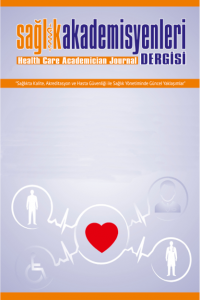Nijeryalı Gençler Arasında Artan Suç Faaliyetleri Dalgasının ve Sosyal Hizmet Rollerine İlişkin Algıların Eleştirel Bir Değerlendirmesi
Nijeryalı Gençler, Suç Faaliyetleri, Adli Sosyal Hizmet
A Critical Assessment of The Rising Wave of Criminal Activity and Perceptions of Social Work Roles Among Nigerian Youth
Crime, Nigerian Youth Ciriminal Activities, Young Unemployement, Criminal Justice Social Worker,
___
- REFERENCES 1. Damachi, N. A. (2001). Evaluation of past Policy Measures for Solving Unemployment Problems. Bullion, 25(4), 6-12.
- 2. Aremu, M. A., Ahmed Y. A. (2011). An Investigation of Security and Crime Management in Developing Society: The Implications for Nigeria Democratic Set-Up. Int. J. Acad. Res. Bus. Soc. Sci. 3(1): 390-399.
- 3. Victor, E., Chika, D. M., Innocent, I, (2019). Investigating the Impact of Crime Reporting on Crime Control in Gwagwalada Area Council Abuja, North Central Nigeria. International Journal of Academic Research in Business, Arts and Science (IJARBAS.COM). Vol. 1, Issue 3. pp 36-53
- 4. Okafor, E. E. (2011). Youth Unemployment and Implication for Stability of Democracy in Nigeria. J. Sustainable Deve. Afr. 13(1): pp 358-373.
- 5. National Bureau of Statistics (NBS) (2009)., Social Statistics in Nigeria, Abuja, NBS Publication.
- 6. Adebayo, A. (1999). Youth Unemployment and National Directorate of Employment-Self Employment Program. Nigerian Journal of Economics and Social Studies 41 (1), pp.81-102.
- 7. National Bureau of Statistics (NBS) (2011). Annual Abstract of Statistics and Labour Force Survey, Abuja National Bureau of Statistics. September, 2012.
- 8. Osawe, C. O. (2015). Increase Wave of Violent Crime and Insecurity: A Threat to Socio-Economic Development in Nigeria. IOSR Journal of Humanities and Social Science (IOSR-JHSS), 20(1), 123-133. . 2021, Vol. 8, No. 1, pp. 31-40
- 9. Tambari, W., & Imoh-Ita, I. (2016). Youth unemployment and crime rate in the niger delta: A comparative analysis of its intensity in Akwa Ibom, Bayesla and River State. IOSR Journal of Humanities and Social Science (IOSR-JHSS), 21(2), 07-11.
- 10. Ogbebor, G. (2012). Youth Violence in Contemporary Nigeria Society: A Psychological Approach. Journal of State and Society, Vol. 2, No. 1, November, pp. 53-59.
- 11. Uddin, P. (2013). Causes, Effects and Solutions to Youth Unemployment Problems in Nigeria: Journal of Emerging Trends in Economics and Management Sciences, Vol. 4 (4), pp.397-402.
- 12. Nigeria Police Force (2012)., Police Crime. Statistics and Records in National Security, Intelligence and Records
- 13. Cleen Foundation (2010). Public Perception of Crime: National Crime Survey, Abuja Cleen Foundation.
- 14. Doreo, P. (2013). The Nigerian Unemployment Challenge: African Report Features.
- 15. Edet, E. D., (2012). The Nature and Consequences of Juvenile Delinquency in Nigeria: A study of Enugu North LGA, Enugu State. Unpublished
- 16. Ekeji, C. C. (2019). Poverty and crime among Youths in Nigeria. Retrieved from: https://www.academia.edu/4819129/poverty and crime among youths in Nigeria.
- 17. Ezie, O. (2012). Youth Unemployment and Its Socio-Economic Implications in Nigeria.Journal of Social Sciences and Public Policy, Vol. 4, September, pp. 49-57.
- 18. Gemlik, N. , Pektaş, A. & Arslanoğlu, A. (2021). COVİD-19 Salgını Sürecinde Twitter Haberciliği Üzerine Nitel Bir Araştırma . Sağlık Profesyonelleri Araştırma Dergisi , 3 (1) , 15-24 .
- ISSN: 2148-7472
- Yayın Aralığı: Yılda 4 Sayı
- Başlangıç: 2014
- Yayıncı: Dünya Kongre
HEMŞİRELERİN ZAMAN YÖNETİMİ KONUSUNDAKİ BAŞARI DÜZEYLERİNİN DEĞERLENDİRİLMESİ
Covid 19 pandemisinin hemşirelerin psikolojik sağlamlık anksiyete ve depresyon düzeylerine etkisi
Hemşirelik Eğitimine Değişen ve Gelişen Teknolojilerin Yansımaları
Duygu Ceren GÜNGÖR, Fatma ORGUN, Nilay ÖZKÜTÜK
Sağlık Turizmi İşletmelerinde Dijital Pazarlama Uygulamalarının Analizi: Kuşadası Örneği
Banu ŞİMŞEK, Ahu YAZICI AYYILDIZ
Doğuma Hazırlık sınıflarında verilen eğitimin doğum memnuniyeti üzerine etkisi
Melike DİŞSİZ, Naciye GELEBEK, Şenay DEMİRBAŞ MEYDAN, Rojjin MAMUK, Dilek BİLGİÇ
Pelvik organ prolapsusu hakkında en çok alıntı yapılan 100 makale: Bibliyometrik analiz
Ayhan ATIGAN, Alev ATIGAN, Soner GÖK
Bilge ÖNAL DÖLEK, Ajala Dare ADELEKE
Hekimlerin Klinik Kaliteye Bakış Açısını Ölçmeye Yönelik Bir Ölçek Geliştirme: Metodolojik Çalışma
Mehmet KOCA, Feyza İNCEOĞLU, Alev KÖKSAL, Serdar DENİZ
İnmeli Hastalara Bakım Verenlerde Bakım Yükü, Anksiyete ve Depresyon Düzeyinin İncelenmesi
